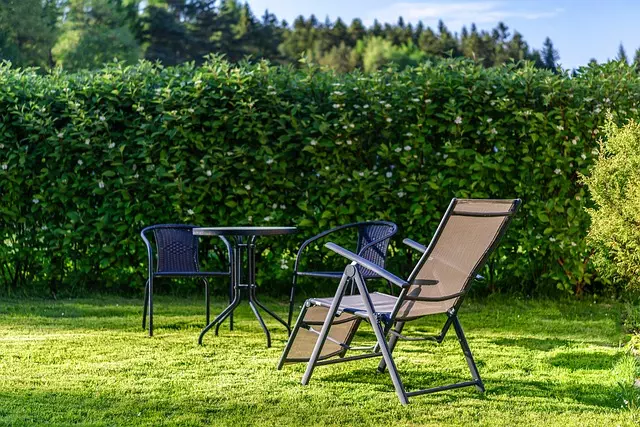Mulching and edging are key components of effective lawn care and landscaping, significantly improving grass health and landscape aesthetics. Mulching helps conserve soil moisture, suppresses weed growth, releases nutrients into the soil as it decomposes, and modulates soil temperature, which is essential for maintaining a healthy lawn. Edging, on the other hand, distinguishes between the lawn and surrounding areas, preventing grass from overgrowing onto walkways or garden beds, and minimizing maintenance. These practices together contribute to a well-maintained landscape, enhancing curb appeal and showcasing a homeowner's dedication to professional lawn care and landscaping. Implementing both mulching and edging can elevate a yard from ordinary to outstanding, making them indispensable in any comprehensive lawn maintenance routine. These strategies not only make your lawn look great but also support its long-term health, highlighting the importance of these practices in lawn care and landscaping.
title: “Enhancing Your Lawn’s Beauty and Health with Smart Mulching and Edging”
A well-maintained lawn is a hallmark of exceptional landscaping. This article delves into the pivotal practices of mulching and edging, key components of lawn care that not only bolster your grass’s health but also significantly amplify your property’s curb appeal. Understanding the nuances of mulching for soil enrichment and learning effective edging techniques are essential steps in achieving a pristine and lush lawn environment. Discover how combining these two methods can lead to optimal lawn health and aesthetics, transforming your outdoor space into a verdant oasis.
- Understanding the Role of Mulching in Lawn Care and Landscaping
- Effective Techniques for Edging Your Lawn to Enhance Curb Appeal
- Combining Mulching and Edging for Optimal Lawn Health and Aesthetics
Understanding the Role of Mulching in Lawn Care and Landscaping

Mulching plays a pivotal role in maintaining a healthy lawn, contributing significantly to effective lawn care and landscaping practices. By applying a layer of organic material on the soil’s surface, mulching helps retain moisture, which is crucial for grass growth, especially during drier spells. This organic matter breaks down over time, enriching the soil with essential nutrients that support robust plant development. Additionally, mulch acts as a barrier between the grass and weeds, preventing unwanted vegetation from competing with your lawn for water and sunlight. It also aids in temperature regulation, keeping the roots cooler in summer and warmer in winter. When integrating mulching into your lawn care routine, consider the type of mulch best suited to your local soil conditions and the specific needs of your grass variety. Regularly applying mulch can significantly enhance the overall health and aesthetic appeal of your landscape, making it a key element in professional-level lawn care and landscaping.
Edging complements the benefits of mulching by creating clear boundaries between your lawn and garden beds or other landscaping features. This delineation not only improves the visual definition of your lawn’s edges but also prevents grass from encroaching onto pathways, driveways, or flowerbeds. Effective edging reduces the amount of maintenance required for both the lawn and surrounding areas by confining growth to designated spaces. It can be achieved through various methods, including physical barriers like metal or plastic edging, or by maintaining a clean line with tools such as lawn edgers. Proper edging is an often-overlooked aspect of comprehensive lawn care and landscaping, yet it contributes significantly to the overall tidiness and presentation of your outdoor space. Combining mulching with precise edging enhances the curb appeal of your property and demonstrates a commitment to meticulous lawn maintenance.
Effective Techniques for Edging Your Lawn to Enhance Curb Appeal

Maintaining a well-defined edge around your lawn is a fundamental aspect of effective lawn care and landscaping that significantly enhances curb appeal. Edging not only keeps your lawn looking neat and tidy but also prevents grass from encroaching on garden beds, walkways, or driveways. To achieve clean and crisp edges, the first step is to select the right edging tool for your yard’s size and terrain. Options range from manual steel edge trimmers for smaller spaces to motorized gas or battery-operated border trimmers for larger properties.
Once you have the appropriate equipment, the process begins with a thorough assessment of your lawn’s perimeter. Use a garden hose to mark out a straight line where you intend to edge, ensuring it aligns with any existing borders or hardscapes. Carefully operate the edging tool along this marked line, removing overgrown grass and sod to define the boundary between your lawn and adjoining areas. After edging, consider using decorative rocks, mulch, or landscape timbers to further delineate the space and add an aesthetic touch that complements your overall landscaping design. Regular maintenance, including periodic re-edging and the application of fresh mulch, will maintain these clear lines, thereby keeping your lawn’s edges sharp and your property’s curb appeal at its best.
Combining Mulching and Edging for Optimal Lawn Health and Aesthetics

Regular lawn care and landscaping practices play a pivotal role in maintaining a healthy and visually appealing lawn. Mulching, a common yet effective technique, serves multiple purposes in the lawn environment. It helps to retain soil moisture, suppress weeds, and gradually enrich the soil as it breaks down. By applying a consistent layer of organic mulch around plants, lawns benefit from the slow release of nutrients into the soil, which supports grass growth and vigor. Additionally, edging delineates the boundary between the lawn and garden beds or walkways, contributing to a well-manicured appearance. When combined, mulching and edging enhance the overall aesthetics of the landscape while promoting optimal lawn health. The clean lines created by edging not only make the yard look tidier but also prevent grass from encroaching on garden areas, which can lead to competition for resources and potential turf damage. By integrating these two practices into a regular lawn care routine, homeowners can achieve both functional and aesthetic goals, resulting in a lawn that is not only healthy but also visually pleasing throughout the seasons. Implementing mulching and edging as part of your landscaping strategy is an investment in the longevity and beauty of your lawn.
lawns thrive with targeted care practices, including mulching and edging. These essential techniques not only bolster a lawn’s health but also significantly improve its aesthetic appeal. Homeowners looking to elevate their outdoor spaces through Lawn Care and Landscaping should consider integrating these practices into their routine for sustained, vibrant growth and well-defined boundaries that catch the eye. By understanding how mulch can conserve soil moisture and suppress weeds, while edging sharpens the demarcation of lawn and garden areas, lawn enthusiasts can achieve a lush, manicured landscape that stands out in any neighborhood. These combined efforts reflect a commitment to high-quality Lawn Care and Landscaping, ensuring properties remain well-maintained and visually pleasing all year round.


